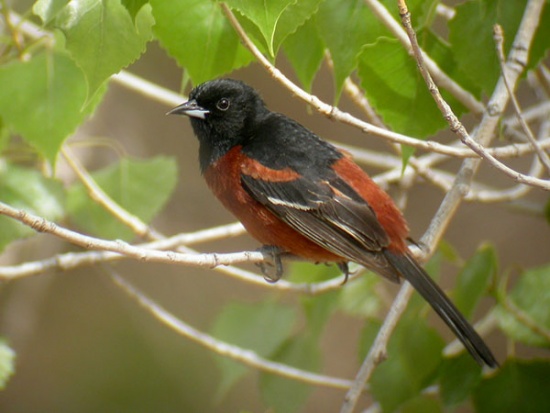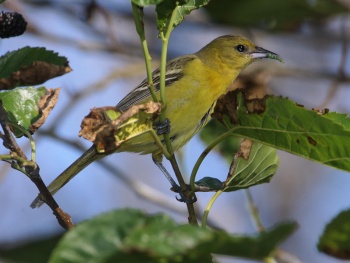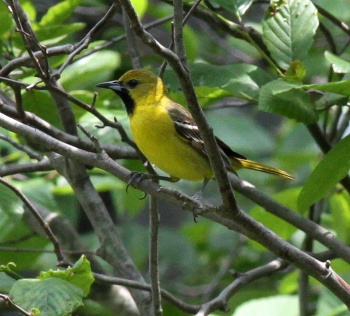(Picture showing open wing. References updated) |
|||
| Line 10: | Line 10: | ||
Female/young [[Hooded Oriole]]s can be quite similar, but notice they have a slimmer, longer, more [[Topography#Beaks|decurved]] bill and a graduated tail. | Female/young [[Hooded Oriole]]s can be quite similar, but notice they have a slimmer, longer, more [[Topography#Beaks|decurved]] bill and a graduated tail. | ||
==Distribution== | ==Distribution== | ||
| + | [[Image:IMG 18521.JPG|thumb|350px|right|First Year Male<br />Photo by {{user|tetoneon|tetoneon}}<br />Northwest [[New Jersey]], June 2011]] | ||
Eastern [[United States]] from eastern [[Montana]] and eastern [[New Mexico]] east and north to southern [[Michigan]], central [[New York]], and [[Massachusetts]] south into central [[Mexico]]; absent from southern [[Florida]]. Recent results suggest that at least part of the US population after having bred in early parts of summer migrates to north-western Mexico where a second round of breeding takes place. | Eastern [[United States]] from eastern [[Montana]] and eastern [[New Mexico]] east and north to southern [[Michigan]], central [[New York]], and [[Massachusetts]] south into central [[Mexico]]; absent from southern [[Florida]]. Recent results suggest that at least part of the US population after having bred in early parts of summer migrates to north-western Mexico where a second round of breeding takes place. | ||
| Line 15: | Line 16: | ||
Rare to casual vagrant in western United States. | Rare to casual vagrant in western United States. | ||
==Taxonomy== | ==Taxonomy== | ||
| − | |||
====Subspecies==== | ====Subspecies==== | ||
| + | [[Image:Orchard Oriole Anahuac.jpg|thumb|350px|right|Male, subspecies ''spurius''<br />Photo by {{user|Stanley+Jones|Stanley Jones}}<br />[[Anahuac National Wildlife Refuge]], Chambers County, [[Texas]], [[USA]], April 2018]] | ||
Two subspecies accepted<sup>[[#References|[1]]]</sup>: | Two subspecies accepted<sup>[[#References|[1]]]</sup>: | ||
* ''I. s. spurius'': | * ''I. s. spurius'': | ||
| − | *Breeds from south east [[Canada]] to [[Mexico]], winters to [[Colombia]] and [[Venezuela]] | + | :*Breeds from south east [[Canada]] to [[Mexico]], winters to [[Colombia]] and [[Venezuela]] |
* ''I. s. fuertesi'': | * ''I. s. fuertesi'': | ||
:*[[Caribbean]] coast of Mexico (mainly Veracruz), winters on Pacific coast straight S of breeding area, and possibly other places | :*[[Caribbean]] coast of Mexico (mainly Veracruz), winters on Pacific coast straight S of breeding area, and possibly other places | ||
| Line 35: | Line 36: | ||
'''Song''': a musical chirping warble. Best heard in the spring soon after the male arrives. | '''Song''': a musical chirping warble. Best heard in the spring soon after the male arrives. | ||
==References== | ==References== | ||
| − | #{{Ref- | + | #{{Ref-Clements6thAug17}}# [http://www.pnas.org/content/early/2009/10/23/0908121106.full.pdf+html?sid=8b8b4693-427c-44f1-bc91-c5e033220adc Paper] describing migration to second breeding area |
#Handbook of the Birds of the World Alive (retrieved June 2017) | #Handbook of the Birds of the World Alive (retrieved June 2017) | ||
#Wikipedia | #Wikipedia | ||
Revision as of 21:12, 21 April 2018
- Icterus spurius
Includes: Ochre Oriole
Identification
15–17 cm (6-6½ in)
Males are bright chestnut underneath, while the head, back, tail, and wings are black; a thin straight bill.
Females and immatures are olive-green above with two white wing-bars and yellowish underparts; immature males have a dark throat.
Similar Species
Female/young Hooded Orioles can be quite similar, but notice they have a slimmer, longer, more decurved bill and a graduated tail.
Distribution
Eastern United States from eastern Montana and eastern New Mexico east and north to southern Michigan, central New York, and Massachusetts south into central Mexico; absent from southern Florida. Recent results suggest that at least part of the US population after having bred in early parts of summer migrates to north-western Mexico where a second round of breeding takes place.
Winters in Central America south to Colombia and Venezuela. Rare to casual vagrant in western United States.
Taxonomy
Subspecies

Photo by Stanley Jones
Anahuac National Wildlife Refuge, Chambers County, Texas, USA, April 2018
Two subspecies accepted[1]:
- I. s. spurius:
- I. s. fuertesi:
- Caribbean coast of Mexico (mainly Veracruz), winters on Pacific coast straight S of breeding area, and possibly other places
fuertesi is sometimes split as full species, Ochre Oriole or Fuerte's Oriole.
Habitat
Open woodland, trees along streams, rivers and lakes, and on farms and parklands. Avoids dense woodland.
Behaviour
Diet
Their main diet consists of insects such as flies and ants, with the addition of berries and nectar; also flower parts.
Breeding
They construct a deep, hanging cup nest, from grass fibres. It is hidden within dense foliage, often in a cluster of trees. The young fledge 11 to 14 days after hatching.
Vocalisation
Song: a musical chirping warble. Best heard in the spring soon after the male arrives.
References
- Clements, J. F., T. S. Schulenberg, M. J. Iliff, D. Roberson, T. A. Fredericks, B. L. Sullivan, and C. L. Wood. 2017. The eBird/Clements checklist of birds of the world: v2017, with updates to August 2017. Downloaded from http://www.birds.cornell.edu/clementschecklist/download/
- Paper describing migration to second breeding area
- Handbook of the Birds of the World Alive (retrieved June 2017)
- Wikipedia
Recommended Citation
- BirdForum Opus contributors. (2024) Orchard Oriole. In: BirdForum, the forum for wild birds and birding. Retrieved 19 April 2024 from https://www.birdforum.net/opus/Orchard_Oriole






